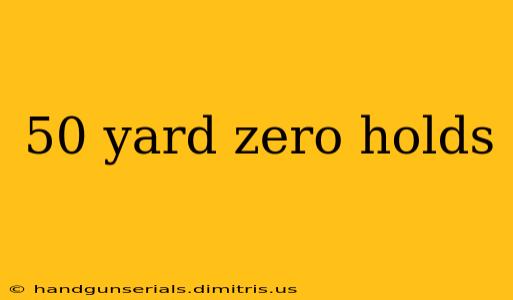The 50-yard zero is a crucial benchmark for riflemen, representing the point where your rifle's trajectory intersects with your point of aim at 50 yards. Achieving this zero is fundamental to longer-range accuracy and understanding your rifle's ballistics. This guide will delve into the intricacies of establishing a 50-yard zero, covering everything from preparation to troubleshooting common issues.
Understanding the Significance of a 50-Yard Zero
Before diving into the practical aspects, let's clarify why the 50-yard zero holds such importance. While you might initially think of zeroing at shorter distances (like 25 yards), the 50-yard zero offers several advantages:
-
Optimal for Most Hunting and Target Shooting: 50 yards falls within the practical shooting range for many hunting scenarios and target competitions. Zeroing at this distance provides a good compromise for shots at various ranges within the hunting field.
-
Better Compensation for Bullet Drop: At longer ranges, bullet drop becomes a significant factor. A 50-yard zero allows you to accurately predict bullet drop at longer distances, with relatively minimal adjustments.
-
Reduced Wind Drift Sensitivity: While wind still affects projectiles, at 50 yards, its influence is comparatively less significant than at longer ranges, making zeroing more consistent.
Equipment and Preparation for Zeroing Your Rifle
To effectively achieve a 50-yard zero, you'll need the following:
- Your Rifle: Ensure your rifle is properly cleaned and maintained.
- Ammunition: Use the same type and brand of ammunition you plan on consistently using for hunting or target practice. Consistency is key.
- Shooting Rest: A solid rest, such as a shooting bag or bipod, is crucial for stable and consistent shooting.
- Target: Use a target with clear aiming points. A brightly colored target against a contrasting background is recommended.
- Optics: Ensure your scope is properly mounted and torqued.
- Tools: Have a screwdriver or other necessary tools for making adjustments to your scope.
- Safety Gear: Always prioritize safety. Wear appropriate eye and ear protection.
Step-by-Step Guide to Zeroing Your Rifle at 50 Yards
1. Set Up Your Shooting Position: Establish a stable and comfortable shooting position using your chosen rest. Consistency in your shooting posture is vital for accurate zeroing.
2. Sight in at a Shorter Range (Optional): Some shooters prefer to begin by roughly zeroing at a closer range (e.g., 25 yards). This initial step makes fine-tuning at 50 yards more efficient.
3. Fire Your First Group: Fire a three-shot group at 50 yards. Observe the point of impact relative to your point of aim.
4. Adjust Your Scope: Based on where your shots landed, adjust your scope's windage (left/right) and elevation (up/down) turrets according to your specific scope's adjustment instructions. Most scopes have a 1/4 MOA (Minute of Angle) or 1/8 MOA adjustment. One MOA equals approximately one inch at 100 yards.
5. Repeat and Refine: Fire another three-shot group and repeat the adjustment process until your point of impact is centered on your target.
6. Final Verification: Once you have achieved a satisfactory zero, fire a final group of five shots to confirm consistency.
Troubleshooting Common Zeroing Issues
- Groups consistently off to one side: This usually indicates a scope mounting issue or an error in your shooting technique.
- Wide or erratic groups: This might indicate a problem with ammunition, the rifle's action, or inconsistent shooting technique.
- Groups consistently high or low: This usually means the elevation adjustments need further refinement.
Beyond the 50-Yard Zero: Understanding Ballistics
Successfully achieving a 50-yard zero is just the first step. Understanding bullet trajectory and applying this knowledge to different ranges is crucial for consistent accuracy. Learning about bullet drop compensation and windage correction will allow you to extend your shooting capabilities far beyond the 50-yard mark.
Remember: Practice, patience, and consistent technique are key to mastering the art of zeroing your rifle. With diligent effort, you'll be consistently hitting your targets with increased confidence.

